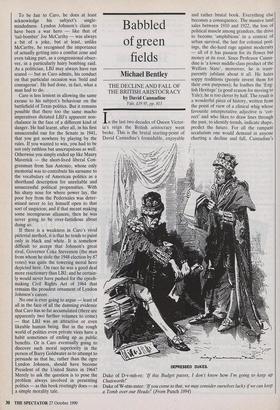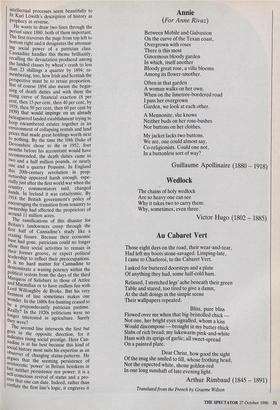Babbled of green fields
Michael Bentley
THE DECLINE AND FALL OF THE BRITISH ARISTOCRACY by David Cannadine Yale, f19.95, pp. 813 In the last two decades of Queen Victor- ia's reign the British aristocracy went broke. This is the brutal starting-point of David Cannadine's formidable, enjoyable and rather brutal book. Everything else becomes a consequence. The massive land sales between 1910 and 1922, the loss of political muscle among grandees, the drive to become 'amphibious' in a context of urban survival, the lust for colonial post- ings, the die-hard rage against modernity — all of it has passion for its flower but money at its root. Since Professor Canna- dine is 'a lower middle-class product of the Welfare State', moreover, he is trans- parently jubilant about it all. He hates soppy traditions (people invent them for their own purposes); he loathes the 'Eng- lish Heritage' (a good reason for moving to Yale); he is too clever by half. The result is a wonderful piece of history, written from the point of view of a clinical whig whose favourite interpretative adjective is 'cor- rect' and who likes to draw lines through the past, to identify trends, indicate shape, predict the future. For all the rampant secularism one would demand in anyone charting a decline and fall, Cannadine's Duke of D-v-nsh-re: `If this Budget passes, I don't know how I'm going to keep up Chatsworth!'
Duke of W-stm-nster: 'If you come to that, we may consider ourselves lucky if we can keep a Tomb over our Heads!' (From Punch 1894)
intellectual processes seem beautifully to fit Karl Lowith's description of history as prophecy in reverse.
He wants to draw two lines through the period since 1880, both of them important. The first traverses the page from top left to bottom right and it designates the attenuat- ing social power of a patrician class. Cannadine handles this theme brilliantly, recalling the devastation produced among the landed classes by wheat's crash to less than 23 shillings a quarter by 1894; re- membering, too, how Irish and Scottish the perspective must be to retain proportion. But of course 1894 also meant the begin- ning of death duties and with them the rising curve of financial exaction (8 per cent, then 15 per cent, then 40 per cent, by 1919, then 50 per cent, then 60 per cent by 1939) that would impinge on an already beleaguered landed establishment trying to keep encumbered estates together in an environment of collapsing rentals and land Prices that made great holdings worth next to nothing. By the time the 10th Duke of Devonshire chose to die in 1952, four months before his accountant would have recommended, the death duties came to two and a half million pounds, or nearly One and a quarter Poussins. In England this 20th-century revolution in prop- rietorship appeared harsh enough, espe- cially just after the first world war when the country, commentators said, changed hands. In Ireland it was cataclysmic. By 1914 the British government's policy of encouraging the transition from tenantry to ownership had affected the proprietors of around 11 million acres.
The ramifications of this disaster for Britain's landowners creep through the first half of Cannadine's study like a crazing fissure. Because their economic base had gone, patricians could no longer allow their social activities to remain in their former groove, or expect political leadership to reflect their preoccupations. It is no hard matter for Cannadine to demonstrate a waning potency within the political system from the days of the third Marquess of Salisbury to those of Attlee and Macmillan or to have endless fun with Lord Willoughby de Broke. But his very firmness of line sometimes makes one v41,_ onder. In the 1880s fox-hunting ceased to 'e a preponderantly patrician pastime. Really? In the 1920s politicians were no longer interested in agriculture. Surely they Were?
The second line intersects the first but goes in the opposite direction, for it indicates rising social prestige. Here Can- nadine is at his best because this kind of
social history most suits his expertise as an observer of changing status-patterns. He argues that the seeming persistence of fact 'power' in Britain betokens in
iact neither persistence nor power: it is a self-conscious revival of status and a pro-
cess that one can date. Indeed, rather than confute the first line's logic, it engraves it more deeply by showing how desperate the aristocracy had become by the 1920s to compensate for lost power by seeking new honour, especially if it were salaried. This is why it suddenly became so important to write one's memoirs for a large advance or do a society column for the newspapers, become governor of a colonial territory, allow oneself to become chairman of a bank or, if all came to nought, to go to Kenya to fornicate. (Cannadine is curious- ly monocausal about Kenya). When all did fail, and nemesis came to many after the second world war, the consequences might prove truly pitiful:
The ninth Earl of Buckinghamshire . . . ended his career as a municipal gardener in Southend. The present Earl of Breadal- bane lives in a bed-sitting-room in Fin- chley . . . Earl Nelson is a police constable. Lord Northesk is a jewelsmith in the Isle of Man. The Countess of Mar is a saleswoman for British Telecom. Lord Simon Conyng- ham is an assistant in a delicatessen. Lord Teviot is a bus conductor.
Professor Cannadine's book is splendid reading and the publishers deserve congra- tulation for making it available to general readers at a sensible price. There are many trivial reservations. One telling one lingers over the question of sources, and it merits mention if only pour encourager les autres.
Of necessity this great sweep of a book employs solely printed material. Accord- ingly, Cannadine's aristocrats have found their Gilray. But in the drawers of a thousand estate agents, solicitor's safes and county record offices, the yellowing detri- tus of a hundred years' inner experience awaits its Gibbon.




































































 Previous page
Previous page